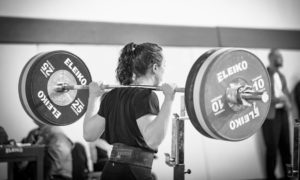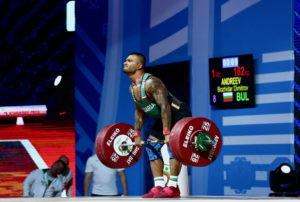
A look at an advanced training method to get super strong
Strength Sensei CP
Wave-like loading is an advanced training method I learned from Canadian National Weightlifting Coach Pierre Roy. Roy “walked the talk” in the Iron Game. At a bodyweight of 176 pounds, his best lifts included a 286 press, a 264 snatch, and a 358 clean and jerk. He retired from competition at 25 but didn’t stop training. At 34, he power cleaned 330 to win a bet.
In conventional weightlifting for maximal strength, an athlete works up to a maximum lift, and if they miss, they usually move on to another exercise or perhaps repeat the weight once more and then move on. With wave-like loading, after missing a maximal lift, you would reduce the weight and work back up and try for a new maximum or perform a sub-maximal weight. Elite lifters might perform 3-4 such waves in this manner. I saw an elite weightlifter use this method on four waves of front squats, hitting a new maximum at the end of each wave. In effect, wave loading ensures you don’t have any more left in the tank!
The roots of wave-like loading can be traced back to the training methods of Canada’s Doug Hepburn, a legendary strongman who won the super heavyweight winner in the 1953 World Weightlifting Championships. Hepburn broke eight world records in the standing Olympic press, best of 380 pounds in 1954, the first man to bench press 500 pounds. However, it was the Bulgarians, under the direction of head coach Ivan Abadjiev, who popularized this advanced training method.
Bulgaria, a relatively small country, defeated the mighty Russian team in the 1972 Olympics and remained a powerhouse through the 90s. Adadjiev’s lifters won nine golds in the Olympics and 57 World Championships. Abadjiev athletes would train several times a day, often six times a week, and frequently used wave-like loading methods to increase the intensity of their workouts.
 The success of Bulgarian weightlifters in the 70s, 80s, and 90s helped popularize wave-like loading training methods. (This photo by Tim Scott, LiftingLife.com; lead photo by Viviana Podhaiski, LiftingLife.com)
The success of Bulgarian weightlifters in the 70s, 80s, and 90s helped popularize wave-like loading training methods. (This photo by Tim Scott, LiftingLife.com; lead photo by Viviana Podhaiski, LiftingLife.com)
From a physiology perspective, the effectiveness of wave-like loading can be attributed to the principle of post tetanic facilitation (PTF). An extensive explanation of PTF can be found in Roger M. Enoka’s textbook, Neuromechanical Basis of Kinesiology. Enoka says how hard a muscle can contract is influenced by previous contractions of that muscle. In other words, a more powerful contraction in an exercise can be achieved a strong muscular contraction precedes it.
Many coaches use PTF without realizing it. For example, a baseball player might swing a weighted bat before stepping up to the plate, and a football coach might perform have a wide receiver push a heavy sled for 10 yards, immediately release it, and transition into a sprint. Bulgarian weightlifting coach Angel Spassov shocked the weightlifting community when he came to the US in the 80s and had his athletes perform a few heavy squats before snatches (because in most lifting programs, squats are always performed after the classical lifts).
To get you started with PTF training, a good method is the 3-2-1 Wave-Like Loading. Let’s use the example of an individual with a back squat 1-rep max (1RM) of 300 pounds. We will use a 40X1 tempo (as the concentric range must be performed as explosively as possible to stimulate the nervous system maximally), and a four-minute rest period to ensure adequate recovery. The first wave could proceed as follows:
Set 1 – 3 reps @ 270 pounds
Set 2 – 2 reps @ 285
Set 3 – 1 rep @ 300
The second set would proceed as follows:
Set 1 – 3 reps @ 272.5
Set 2 – 2 reps @ 287.5
Set 3 – 1 rep @ 302.5
If you fail on the third set, stop — you’re not ready for another wave. Stop, and move on to another exercise. Don’t be concerned, as three waves would be considered an exceptional workout. If successful, however, move on to this wave:
Set 1 – 3 reps @ 275
Set 2 – 2 reps @ 290
Set 3 – 1 rep @ 305
If successful with the third set, which is possible with exceptionally conditioning athletes, a fourth wave can be performed, as follows:
Set 1 – 3 reps @ 277.5
Set 2 – 2 reps @ 292.5
Set 3 – 1 rep @ 307.5
Again, wave-like loading is an advanced training method suited for those who want to achieve the highest strength levels. When you’re ready for a strength-building challenge, give the 3-2-1 Wave-Like Loading system a shot.
